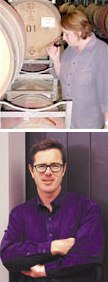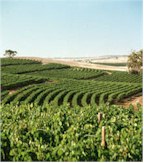


On January 3, 1853 Treloar and his family moved to their new home in Watervale. The house was a simple hut like so many in which pioneer families began their farming lives. On June 15, 1854 Treloar planted his first patch of vines which he obtained as cuttings from a Mr Solly.

During 1858 Francis mentions the building of a more substantial home for his growing family. This home was built from fine old stone, it was named Springvale and remains on the grounds of the Quelltaler property today. In 1859 the vines became productive. Treloar made wine which he sold to local people or used to barter for goods
Harvest wine was also used as payment for work; many labourers were paid a shilling or two and a flagon of wine for a weeks work. In 1862, four years after the family had moved into the Springvale House, Francis sold everything; and left Watervale. The new owner was Captain (later Sir) Walter Watson Hughes who purchased the property for his nephew.
In March 1863, Captain Hughes, who had known Francis Treloar for many years, installed him as Manager. Captain Hughes planted more vines, and other farmers in the district followed. The beautiful stone cellars were established and Francis made the wine at Quelltaler. In 1868 a wine maker by the name of Carl Sobels was employed.

In 1889, 20 years after he inherited Springvale, James Richman sold the property to Carl Sobels and his brother in law Mr Hermann Buring. Sobels immediately instigated planned improvements and extensions. In 1896 Emil Sobels, 27, returned to Springvale to help his father Carl with the increasing work in the cellars. From 1898-1900, the legendary Leo Buring, second son of Hermann Buring, was a cellarhand at Quelltaler. On September 27, 1923 Carl Sobels died and was succeeded by his son Emil Sobels as Manager of the site. 1925 marked the arrival of electricity in the area. The mid North Electricity Company completed the lines and electric power was connected.
1937 - Quelltaler Hock became the first Australian wine to be served at the Lord Mayor's Banquet in London and at the House of Commons. In 1945 contouring of some of the vineyards was carried out on the property. The 100th Anniversary of the firm was celebrated in 1965 on the picnic grounds. The celebration was hosted by Mr & Mrs Larry Sobels.
1967 saw the last of the Sobels family to be appointed to a winemaking and management position, a title held until 1982. This was the Great Grandson of Carl Sobels, Jamie Sobels. In 1969 H Buring and Sobels is sold to Nathan and Wyeth, a Melbourne based company.
1981. French company Remy Martin purchased the holding company of Nathan and Wyeth and thus assumed control of the winery. November 1987, Wolf Blass purchased Quelltaler from Remy Martin and the winery was Australian owned again after a brief period in French hands. In March 1996 the name "Quelltaler" was re-introduced for the first time in almost two decades with the release of the premium Annie's Lane range from the now substantial vineyard holdings across the Clare Valley.
